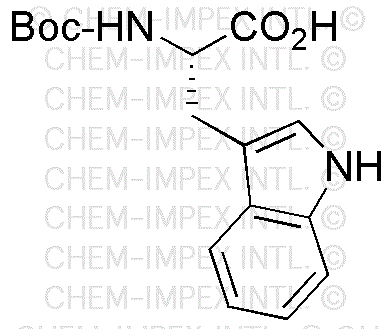Na-Boc-L-tryptophan is widely utilized in research focused on:
- Peptide Synthesis: This compound serves as a key building block in the synthesis of peptides, particularly in the pharmaceutical industry where custom peptides are developed for therapeutic applications.
- Drug Development: Its role in drug discovery is significant, as it helps in the design of compounds that can modulate biological pathways, particularly those involving serotonin receptors.
- Biotechnology: In biotechnological applications, it is used in the production of recombinant proteins, enhancing the yield and stability of proteins during expression in various systems.
- Research on Neurotransmitters: Researchers utilize it to study the metabolism and function of tryptophan in the brain, contributing to a better understanding of mood disorders and potential treatments.
- Analytical Chemistry: It is employed in analytical methods to quantify tryptophan levels in biological samples, aiding in nutritional studies and health assessments.
General Information
Properties
Safety and Regulations
Applications
Na-Boc-L-tryptophan is widely utilized in research focused on:
- Peptide Synthesis: This compound serves as a key building block in the synthesis of peptides, particularly in the pharmaceutical industry where custom peptides are developed for therapeutic applications.
- Drug Development: Its role in drug discovery is significant, as it helps in the design of compounds that can modulate biological pathways, particularly those involving serotonin receptors.
- Biotechnology: In biotechnological applications, it is used in the production of recombinant proteins, enhancing the yield and stability of proteins during expression in various systems.
- Research on Neurotransmitters: Researchers utilize it to study the metabolism and function of tryptophan in the brain, contributing to a better understanding of mood disorders and potential treatments.
- Analytical Chemistry: It is employed in analytical methods to quantify tryptophan levels in biological samples, aiding in nutritional studies and health assessments.
Documents
Safety Data Sheets (SDS)
The SDS provides comprehensive safety information on handling, storage, and disposal of the product.
Product Specification (PS)
The PS provides a comprehensive breakdown of the product’s properties, including chemical composition, physical state, purity, and storage requirements. It also details acceptable quality ranges and the product's intended applications.
Certificates of Analysis (COA)
Search for Certificates of Analysis (COA) by entering the products Lot Number. Lot and Batch Numbers can be found on a product’s label following the words ‘Lot’ or ‘Batch’.
Numéro de catalogue
Numéro de lot/série
Certificates Of Origin (COO)
This COO confirms the country where the product was manufactured, and also details the materials and components used in it and whether it is derived from natural, synthetic, or other specific sources. This certificate may be required for customs, trade, and regulatory compliance.
Numéro de catalogue
Numéro de lot/série
Safety Data Sheets (SDS)
The SDS provides comprehensive safety information on handling, storage, and disposal of the product.
DownloadProduct Specification (PS)
The PS provides a comprehensive breakdown of the product’s properties, including chemical composition, physical state, purity, and storage requirements. It also details acceptable quality ranges and the product's intended applications.
DownloadCertificates of Analysis (COA)
Search for Certificates of Analysis (COA) by entering the products Lot Number. Lot and Batch Numbers can be found on a product’s label following the words ‘Lot’ or ‘Batch’.
Numéro de catalogue
Numéro de lot/série
Certificates Of Origin (COO)
This COO confirms the country where the product was manufactured, and also details the materials and components used in it and whether it is derived from natural, synthetic, or other specific sources. This certificate may be required for customs, trade, and regulatory compliance.


